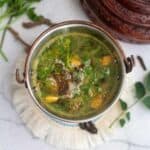Delicious, soothing, and healing rasam recipe (South-Indian style thin soup) with two varieties of long pepper, aka thippili or pipli or pippali! Enjoy this aromatic and healing thippili rasam, perfect for soothing your senses and boosting your health!
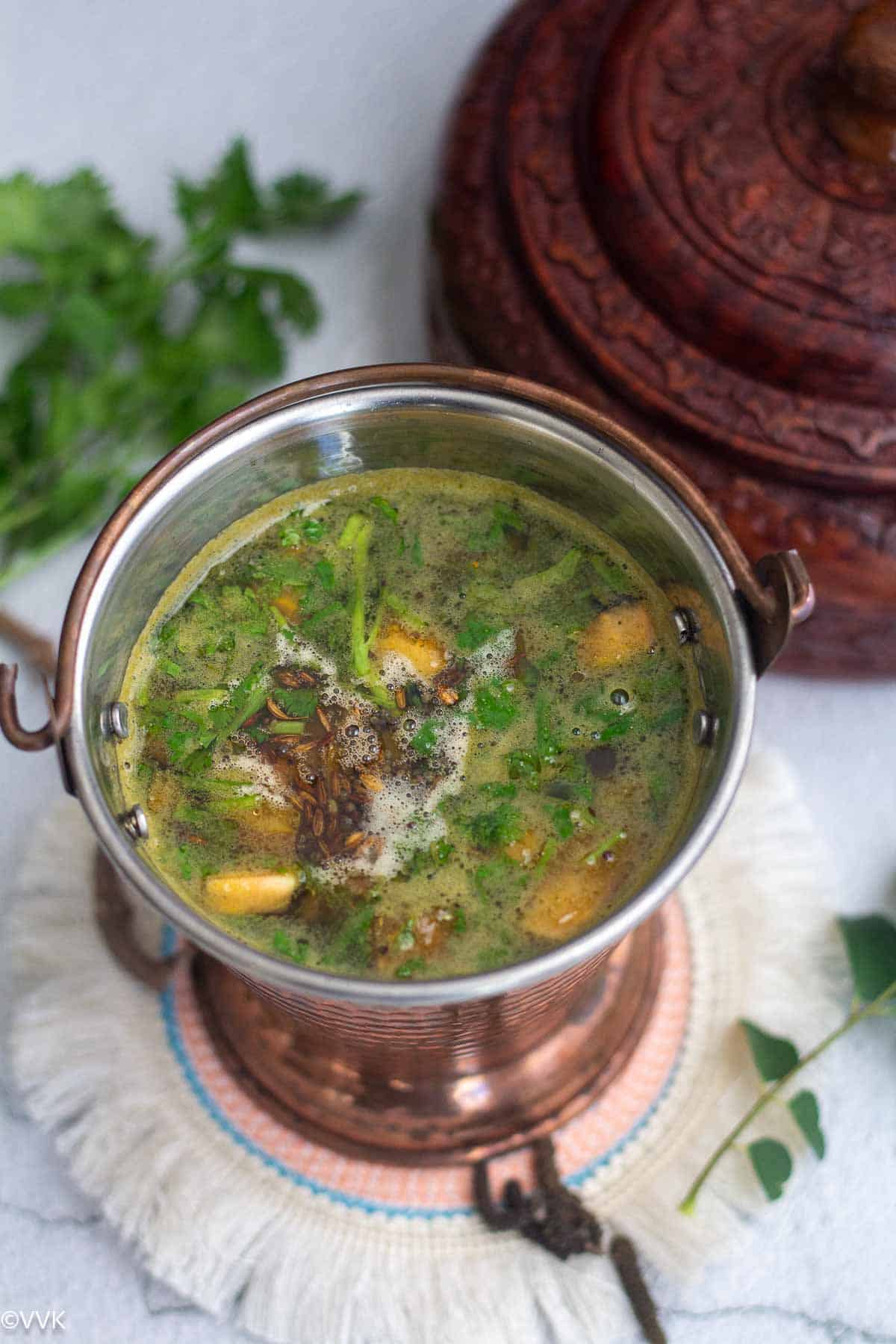
I’ve wanted to share this thippili rasam made with both arisi thippili and kandanthippili for a while, and I’m excited to do so finally. Before diving into the recipe, let’s take a moment to talk about the star ingredient, thippili.
Jump to:
What is thippili or long pepper?
Long pepper, also known as Indian Long Pepper (pipli or pippali), is a flowering vine renowned for its numerous medicinal properties. The dried flower of this plant is called arisi thippili, while its roots are known as kandanthippili. Long pepper, or thippili, is particularly valued for its expectorant properties. It can be used to prepare a kashayam (herbal decoction) or this comforting rasam.
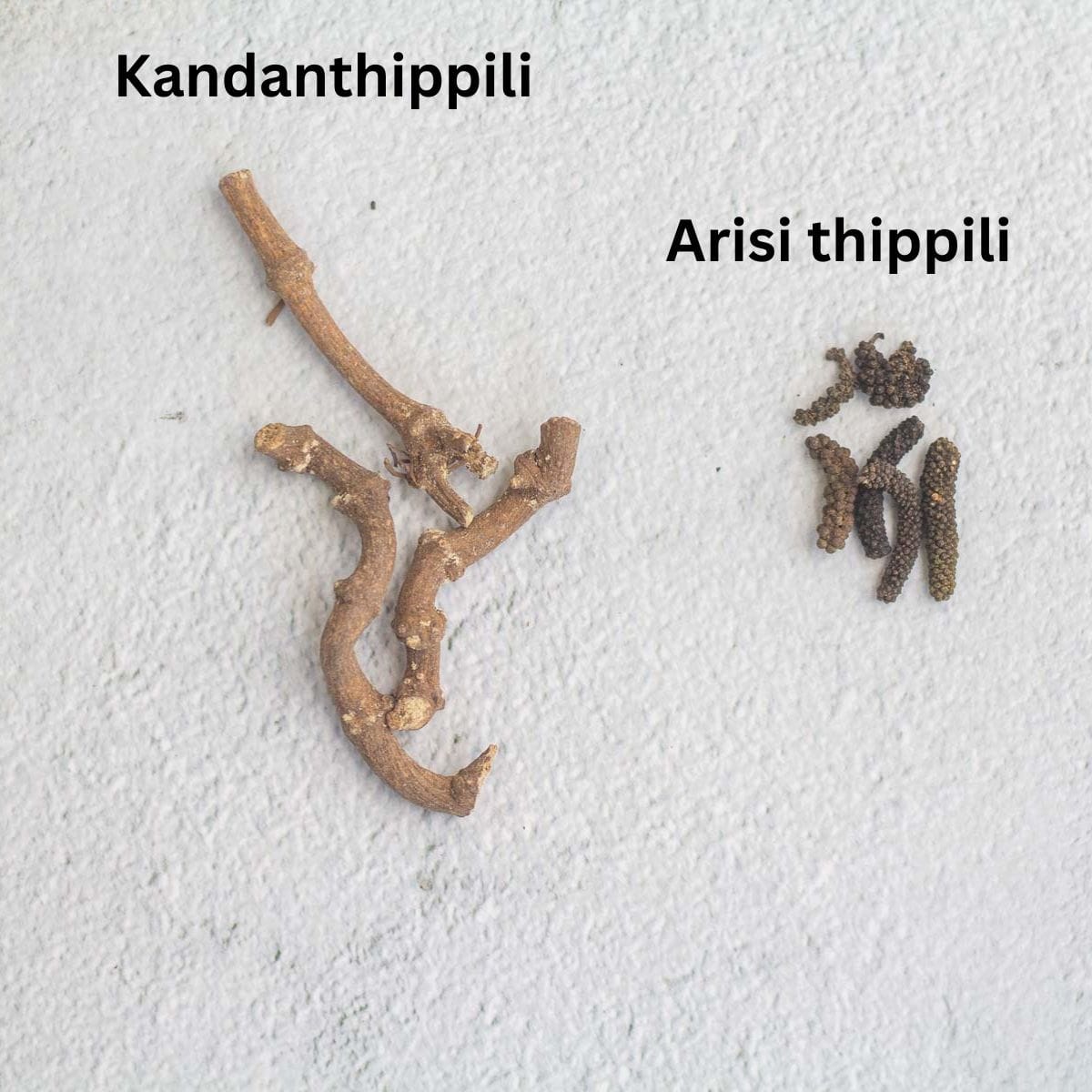
This rasam is especially soothing when you’re feeling under the weather, such as during a bout of the flu. While I enjoy both kashayam and rasam, my love for rasam always makes it my first choice.
In addition to its expectorant properties, long pepper is highly regarded for its numerous other medicinal benefits. It serves as an excellent digestive aid, helps reduce inflammation, and offers a range of therapeutic effects.
Where can you find thippili?
I got mine from India. In Tamil Nadu, arisi thippili is readily available in all naatu marundu kadais (traditional medicine shops), and nowadays, you can even find it in supermarkets. I’ve also come across arisi thippili in Indian grocery stores in the US, and of course, it’s available on Amazon—I’ll share the link here. You can use either one to make the rasam, but if you can get both arisi thippili and kandanthippili, even better—you can use both for enhanced flavor and benefits.
Ingredients required
This rasam is more like my cumin-pepper (jeera milagu) rasam but with long peppers. And here are the ingredients that we need.
Thippili rasam spice mix: We need cumin seeds, whole pepper, long pepper, long pepper roots, toor dal, and curry leaves. Curry leaves add a lot of flavor, and they blend really well with these spices. If you can’t source, please ignore it. The taste of the rasam will be different, but there is no substitute for curry leaves.
Tomatoes and tamarind paste: I have used both tomatoes and tamarind paste for this rasam for the tangy flavor and to balance the spices. I have used my homemade tamarind paste for this recipe. You can use store-bought one or tamarind pulp as well.
For tempering: Finally, to temper, we need ghee or oil along with mustard seeds and cumin seeds.
Apart from these ingredients, we also need turmeric powder, salt, water, cilantro, and optional jaggery. Please check the recipe card for exact measurements.
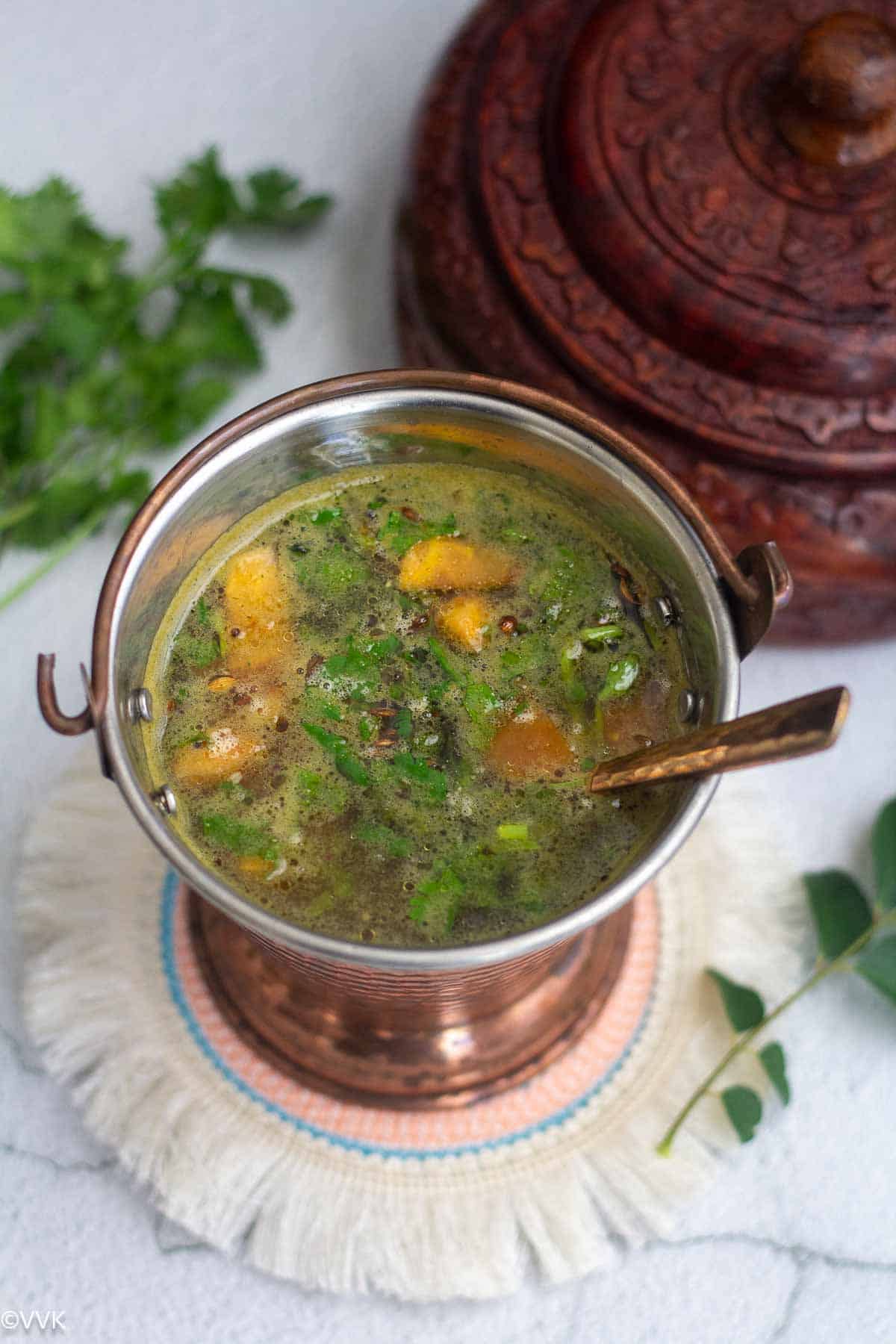
How to serve this rasam
You can enjoy this rasam as a soup. It is very soothing and comforting. Alternatively, you can mix it with rice, millet, or quinoa or with any grain of your choice and enjoy it with legume stir fry or sundal for a balanced meal or with any kootu or dry curries.
How to make thippili rasam
Prepare the spice mix:
- Soak cumin seeds, black pepper, arisi thippili, kandanthippili, toor dal, and curry leaves in water for 30–45 minutes.
- Drain and grind them into a smooth paste with turmeric powder, tamarind paste, and ¼ cup of water.
Cook the rasam:
- In a heavy-bottomed vessel (like an eeya sombu or any sturdy pot), combine the ground paste with chopped tomatoes, salt, cilantro, and 1 cup of water (rinse the mixer jar to use up the residue).
- Bring the mixture to a boil.
- Add three more cups of water, jaggery (if using), and additional cilantro. Reduce the heat to low and let it simmer until frothy.
Temper and serve:
- Heat one teaspoon of ghee or oil in a small pan. Add mustard seeds and cumin seeds. Once the mustard seeds splutter, pour the tempering over the rasam.
- Serve the rasam hot as a soup or with rice, millet, or quinoa for a hearty meal. Pair it with legume stir fry, sundal, kootu, or dry curries for a balanced plate.
Dietary Notes
- Gluten-Free: Naturally gluten-free.
- Nut-Free: Safe for those with nut allergies.
- Vegan Option: Use oil instead of ghee for tempering.
- Storage: Refrigerate for up to 3 days.
Recipe Notes
- Using Tamarind Pulp: If you’re using whole tamarind, soak a marble-sized piece in 1 cup of water for 30 minutes, extract the pulp, and add it to the spice mix.
- Garlic Option: Add two cloves of garlic to the spice mix while grinding for added flavor.
- Texture Preference: Grind the spice mix to your desired texture—smooth or coarse.
- Ingredient Substitution: If kandanthippili is unavailable, increase the amount of arisi thippili to 2 teaspoons.
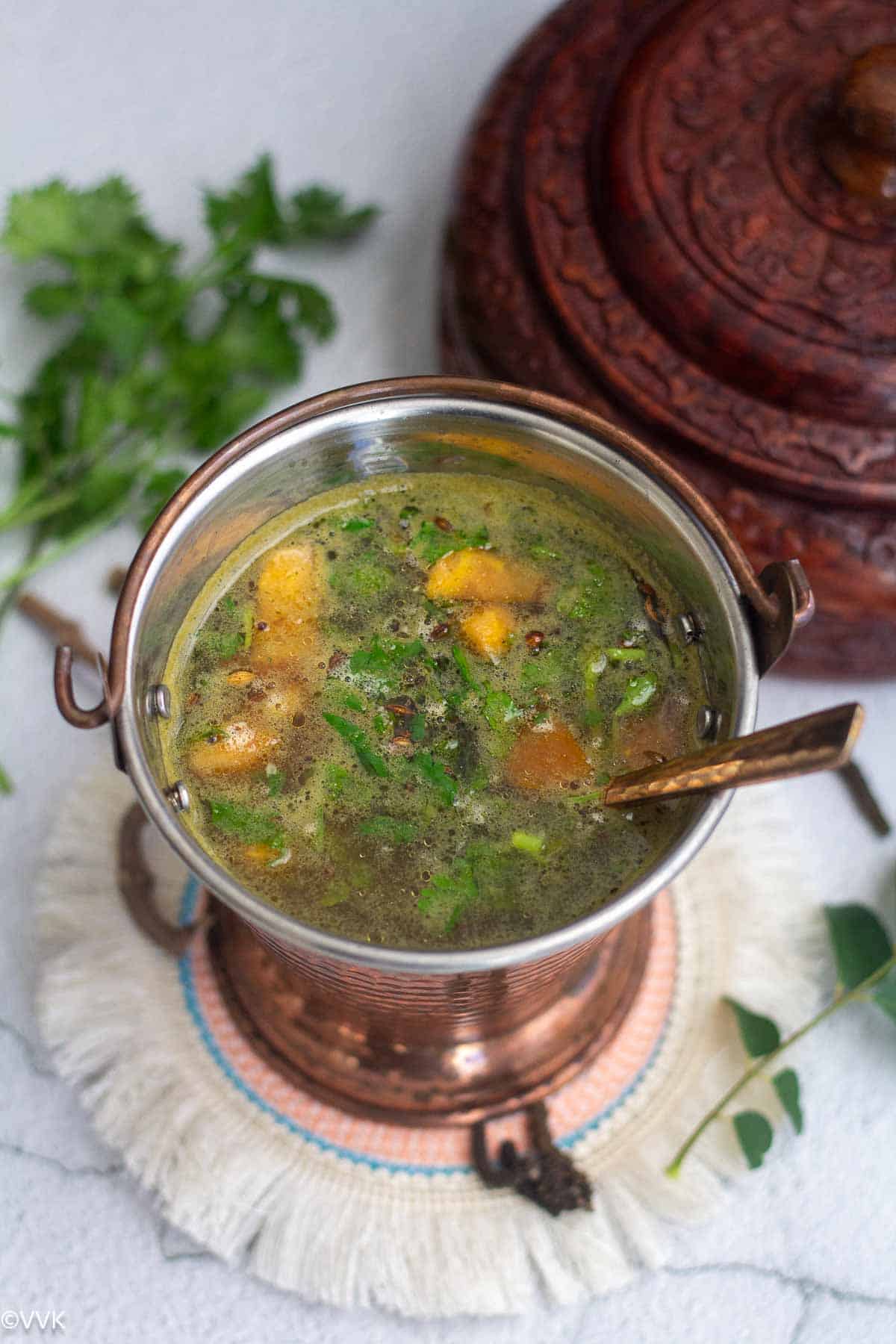
More rasam recipes
If you love rasam like me, then do check out these amazing South Indian rasam recipes.
PS: Follow me on Instagram or join my Facebook Group for more gardening and recipe updates. If you try this thippili rasam recipe, please don’t forget to comment and rate this recipe. If you have any questions, please leave a comment, and I will get to it asap. Make sure to follow me on my Pinterest for more healthy and delicious ideas!
📖 Recipe
Thippili Rasam: A Delicious and Healing South-Indian Soup Recipe
Discover the aromatic and healing power of thippili rasam, a South-Indian style soup made with two varieties of long pepper. Boost your health with this delicious and soothing recipe.
Servings: 4
Calories: 55kcal
Ingredients
Measurement Details: 1 cup = 240ml; 1tbsp = 15ml; 1 tsp =5ml;
Instructions
-
Soak cumin seeds, black pepper, arisi thippili, kandanthippili, toor dal, and curry leaves in water for 30–45 minutes.
-
Drain and grind them into a smooth paste with turmeric powder, tamarind paste, and ¼ cup of water.
-
In a heavy-bottomed vessel (like an eeya sombu or any sturdy pot), combine the ground paste with chopped tomatoes, salt, cilantro, and 1 cup of water (rinse the mixer jar to use up the residue).
-
Bring the mixture to a boil.
-
Add three more cups of water, jaggery (if using), and additional cilantro. Reduce the heat to low and let it simmer until frothy.
-
Heat one teaspoon of ghee or oil in a small pan. Add mustard seeds and cumin seeds. Once the mustard seeds splutter, pour the tempering over the rasam.
-
Serve the rasam hot as a soup or with rice, millet, or quinoa for a hearty meal. Pair it with legume stir fry, sundal, kootu, or dry curries for a balanced plate.
Video
Notes
- Using Tamarind Pulp: If you’re using whole tamarind, soak a marble-sized piece in 1 cup of water for 30 minutes, extract the pulp, and add it to the spice mix.
- Garlic Option: Add two cloves of garlic to the spice mix while grinding for added flavor.
- Texture Preference: Grind the spice mix to your desired texture—smooth or coarse.
- Ingredient Substitution: If kandanthippili is unavailable, increase the amount of arisi thippili to 2 teaspoons.
Nutrition
Calories: 55kcal | Carbohydrates: 8g | Protein: 2g | Fat: 2g | Saturated Fat: 1g | Polyunsaturated Fat: 0.2g | Monounsaturated Fat: 1g | Cholesterol: 3mg | Sodium: 1183mg | Potassium: 174mg | Fiber: 2g | Sugar: 3g | Vitamin A: 618IU | Vitamin C: 155mg | Calcium: 92mg | Iron: 3mg
I am not a nutritionist. The nutritional information is provided as a courtesy and is an estimate only. It varies depending upon the product types or brands.
Update Notes: Earlier posted on 2016, now updated with new pictures, recipe card with nutrition information.


